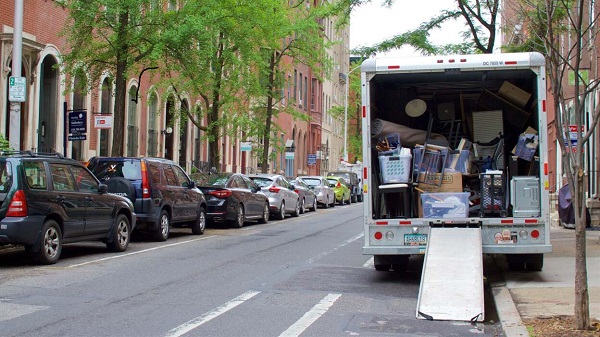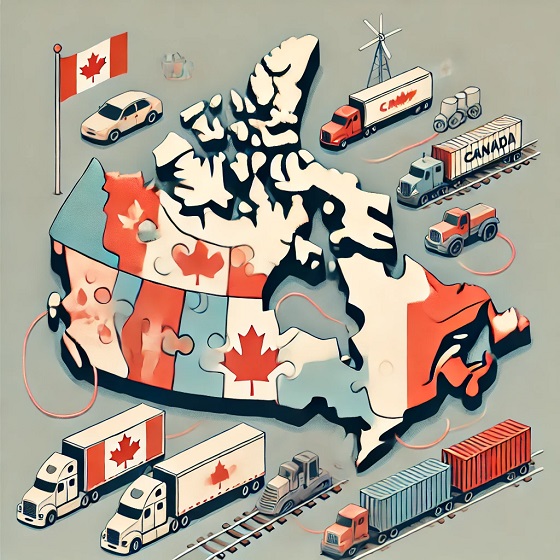Economy
One Solution to Canada’s Housing Crisis: Move. Toronto loses nearly half million people to more affordable locations

From the Frontier Centre for Public Policy
By Wendell Cox
The largest CMA, Toronto, had by far the most significant net internal migration loss at 402,600, Montreal lost 162,700, and Vancouver lost 49,700.
Canadians are fleeing overpriced cities to find more affordable housing. And restrictive urban planning policies are to blame.
Canadians may be solving the housing crisis on their own by moving away from more expensive areas to areas where housing is much more affordable. This trend is highlighted in the latest internal migration data from Statistics Canada.
The data covers 167 areas comprising the entire nation, including Census Metropolitan Areas (CMAs), which have populations from 100,000 to seven million. It also includes the smaller Census Agglomerations (CAs), which have a core population of at least 10,000, as well as areas outside CMAs and CAs in each province and territory, which are referred to as “largely rural areas.”
Long-standing migration trends have been virtually reversed. Larger cities (CMAs) now see the highest loss of net internal migrants, while smaller cities (CAs) are experiencing solid gains. Between 2019 and 2023, Canada’s CMAs lost 273,800 net internal migrants to smaller areas, including CAs and largely rural areas. This contrasts sharply with the previous five-year period (2014 to 2018) when CMAs saw only a 1,000-person loss.
So, where did these people go? A significant portion – 108,100 – moved to CAs, which captured 39 per cent of the CMA losses. This is triple that of the previous five years (2014 through 2018).
However, the most notable shift occurred in largely rural areas, which gained 165,700 net internal migrants, representing 61 per cent of CMA losses. This is a dramatic increase compared to the 33,700 net loss in the previous five years.
Among the 167 areas, the migration data is stunning.
The areas experiencing the greatest net internal migration are outside CMAs and CAs. The largely rural area of Ontario saw the biggest gain, with a net increase of 78,300 people – nearly 40 times the number from the previous five years. Meanwhile, rural Quebec placed second, with a net gain of 76,200 people, more than 10 times the increase in the prior five years. The Calgary CMA ranked third (and first among CMAs) at 42,600, followed by the Ottawa Gatineau CMA (Ontario and Quebec) at 36,700 and the Oshawa CMA at 34,900.
The largest CMA, Toronto, had by far the most significant net internal migration loss at 402,600, Montreal lost 162,700, and Vancouver lost 49,700. Outside these CMAs, nearly all areas posted net gains.
People have also started moving to the Maritimes. The Halifax CMA tripled its previous gain (21,300). In New Brunswick, Moncton nearly quadrupled its gain (7,000). Modest gains were also made in Fredericton and Saint John as well as in Charlottetown in Prince Edward Island.
Meanwhile, housing affordability in Canada’s largest CMAs has become grim. Toronto’s median house price to median household income has doubled in less than two decades. Vancouver’s prices have tripled relative to incomes in five decades. Montreal’s house prices nearly doubled relative to incomes over two decades.
These CMAs (and others) have housing policies typical of the international planning orthodoxy, which seeks to make cities denser. In effect, they have declared war against “urban sprawl,” trying to stop any material expansion of urbanization. These urban containment policies, which include greenbelts, agricultural reserves, urban growth boundaries and compact city strategies, are associated with the worst housing affordability. Land prices are skewed upward throughout the market. Demand continues to increase ahead of incomes, but the supply of low-cost suburban land, so crucial to controlling costs, is frozen.
Regrettably, some areas where people have fled are also subject to urban containment and housing affordability has deteriorated rapidly. Between 2015 and 2022, prices in Ontario CMAs London, Guelph, Brantford and St. Catharines have about doubled. BC’s Fraser Valley and Vancouver Island have seen similar increases. Those moving to these areas are ahead financially, but the rapidly rising house prices are closing opportunities.
There are proposals to restore housing affordability, though none tackle the urban containment policies associated with the price increases. Indeed, we have not found a single metropolitan area where housing affordability has been restored with the market distortions of the intensity that have developed in Toronto, Vancouver and Montreal (not in our Demographia International Housing Affordability report or elsewhere). Such markets have become unsustainable for most new entrant households because they cannot afford to live there.
Housing is not a commodity. Households have varying preferences, from ground-oriented housing (detached and townhomes) to high-rise condos. Indeed, a growing body of literature associates detached housing with higher total fertility rates. According to Statistics Canada, Canadians have favoured lower densities for decades, a trend that continued through the 2021 Census, a trend that continued through the 2021 Census, according to Statistics Canada.
With governments (virtually around the world) failing to maintain stable and affordable housing markets, it’s not surprising people are taking matters into their own hands. Until fundamental reforms can be implemented in the most expensive markets, those seeking a better quality of life will have no choice but to leave.
First published in the Financial Post.
Wendell Cox is a senior fellow at the Frontier Centre for Public Policy and the author of Demographia International Housing Affordability.
Business
It Took Trump To Get Canada Serious About Free Trade With Itself

From the Frontier Centre for Public Policy
By Lee Harding
Trump’s protectionism has jolted Canada into finally beginning to tear down interprovincial trade barriers
The threat of Donald Trump’s tariffs and the potential collapse of North American free trade have prompted Canada to look inward. With international trade under pressure, the country is—at last—taking meaningful steps to improve trade within its borders.
Canada’s Constitution gives provinces control over many key economic levers. While Ottawa manages international trade, the provinces regulate licensing, certification and procurement rules. These fragmented regulations have long acted as internal trade barriers, forcing companies and professionals to navigate duplicate approval processes when operating across provincial lines.
These restrictions increase costs, delay projects and limit job opportunities for businesses and workers. For consumers, they mean higher prices and fewer choices. Economists estimate that these barriers hold back up to $200 billion of Canada’s economy annually, roughly eight per cent of the country’s GDP.
Ironically, it wasn’t until after Canada signed the North American Free Trade Agreement that it began to address domestic trade restrictions. In 1994, the first ministers signed the Agreement on Internal Trade (AIT), committing to equal treatment of bidders on provincial and municipal contracts. Subsequent regional agreements, such as Alberta and British Columbia’s Trade, Investment and Labour Mobility Agreement in 2007, and the New West Partnership that followed, expanded cooperation to include broader credential recognition and enforceable dispute resolution.
In 2017, the Canadian Free Trade Agreement (CFTA) replaced the AIT to streamline trade among provinces and territories. While more ambitious in scope, the CFTA’s effectiveness has been limited by a patchwork of exemptions and slow implementation.
Now, however, Trump’s protectionism has reignited momentum to fix the problem. In recent months, provincial and territorial labour market ministers met with their federal counterpart to strengthen the CFTA. Their goal: to remove longstanding barriers and unlock the full potential of Canada’s internal market.
According to a March 5 CFTA press release, five governments have agreed to eliminate 40 exemptions they previously claimed for themselves. A June 1 deadline has been set to produce an action plan for nationwide mutual recognition of professional credentials. Ministers are also working on the mutual recognition of consumer goods, excluding food, so that if a product is approved for sale in one province, it can be sold anywhere in Canada without added red tape.
Ontario Premier Doug Ford has signalled that his province won’t wait for consensus. Ontario is dropping all its CFTA exemptions, allowing medical professionals to begin practising while awaiting registration with provincial regulators.
Ontario has partnered with Nova Scotia and New Brunswick to implement mutual recognition of goods, services and registered workers. These provinces have also enabled direct-to-consumer alcohol sales, letting individuals purchase alcohol directly from producers for personal consumption.
A joint CFTA statement says other provinces intend to follow suit, except Prince Edward Island and Newfoundland and Labrador.
These developments are long overdue. Confederation happened more than 150 years ago, and prohibition ended more than a century ago, yet Canadians still face barriers when trying to buy a bottle of wine from another province or find work across a provincial line.
Perhaps now, Canada will finally become the economic union it was always meant to be. Few would thank Donald Trump, but without his tariffs, this renewed urgency to break down internal trade barriers might never have emerged.
Lee Harding is a research fellow with the Frontier Centre for Public Policy.
Alberta
Low oil prices could have big consequences for Alberta’s finances

From the Fraser Institute
By Tegan Hill
Amid the tariff war, the price of West Texas Intermediate oil—a common benchmark—recently dropped below US$60 per barrel. Given every $1 drop in oil prices is an estimated $750 million hit to provincial revenues, if oil prices remain low for long, there could be big implications for Alberta’s budget.
The Smith government already projects a $5.2 billion budget deficit in 2025/26 with continued deficits over the following two years. This year’s deficit is based on oil prices averaging US$68.00 per barrel. While the budget does include a $4 billion “contingency” for unforeseen events, given the economic and fiscal impact of Trump’s tariffs, it could quickly be eaten up.
Budget deficits come with costs for Albertans, who will already pay a projected $600 each in provincial government debt interest in 2025/26. That’s money that could have gone towards health care and education, or even tax relief.
Unfortunately, this is all part of the resource revenue rollercoaster that’s are all too familiar to Albertans.
Resource revenue (including oil and gas royalties) is inherently volatile. In the last 10 years alone, it has been as high as $25.2 billion in 2022/23 and as low as $2.8 billion in 2015/16. The provincial government typically enjoys budget surpluses—and increases government spending—when oil prices and resource revenue is relatively high, but is thrown into deficits when resource revenues inevitably fall.
Fortunately, the Smith government can mitigate this volatility.
The key is limiting the level of resource revenue included in the budget to a set stable amount. Any resource revenue above that stable amount is automatically saved in a rainy-day fund to be withdrawn to maintain that stable amount in the budget during years of relatively low resource revenue. The logic is simple: save during the good times so you can weather the storm during bad times.
Indeed, if the Smith government had created a rainy-day account in 2023, for example, it could have already built up a sizeable fund to help stabilize the budget when resource revenue declines. While the Smith government has deposited some money in the Heritage Fund in recent years, it has not created a dedicated rainy-day account or introduced a similar mechanism to help stabilize provincial finances.
Limiting the amount of resource revenue in the budget, particularly during times of relatively high resource revenue, also tempers demand for higher spending, which is only fiscally sustainable with permanently high resource revenues. In other words, if the government creates a rainy-day account, spending would become more closely align with stable ongoing levels of revenue.
And it’s not too late. To end the boom-bust cycle and finally help stabilize provincial finances, the Smith government should create a rainy-day account.
-

 Alberta9 hours ago
Alberta9 hours agoGovernments in Alberta should spur homebuilding amid population explosion
-

 Entertainment2 days ago
Entertainment2 days agoPedro Pascal launches attack on J.K. Rowling over biological sex views
-

 conflict2 days ago
conflict2 days agoTrump tells Zelensky: Accept peace or risk ‘losing the whole country’
-

 Alberta8 hours ago
Alberta8 hours agoLow oil prices could have big consequences for Alberta’s finances
-

 2025 Federal Election1 day ago
2025 Federal Election1 day agoPoilievre Campaigning To Build A Canadian Economic Fortress
-

 Automotive1 day ago
Automotive1 day agoCanadians’ Interest in Buying an EV Falls for Third Year in a Row
-

 International8 hours ago
International8 hours agoHistory in the making? Trump, Zelensky hold meeting about Ukraine war in Vatican ahead of Francis’ funeral
-

 Automotive2 days ago
Automotive2 days agoHyundai moves SUV production to U.S.






